KETEPATAN MODEL ALTMAN, SPRINGATE, ZMIJEWSKI, DAN GROVER DALAM MEMPREDIKSI FINANCIAL DISTRESS
DOI:
https://doi.org/10.22219/jrak.v8i1.28Keywords:
Financial Distress, Altman, Springate, Zmijewski, GroverAbstract
This study aims to identify and analyze the accuracy models of financial distress between the model results of Altman, Springate, Zmijewski, and Grover. The model used by investors, creditors and the company itself who will invest in the company and evaluate the financial performance. Samples from this study are 1.321 firm-year, collected from Indonesia Stock Exchange for the period 2012-2016 and were selected using purposive sampling method. The data used in this study are financial reports of each company. The data obtained were tested with logistic regression. This study shows that the model of Altman, Springate, Zmijewski, and Grover has a significant impact and can be used for predicting the condition of financial distress. However, the Springate model is the most appropriate model for predicting the condition of financial distress because it has the highest level of coefficient determination compared to other models.
Downloads
Downloads
Published
Issue
Section
License

Jurnal Reviu Akuntansi dan Keuangan is licensed under a Creative Commons Attribution-NonCommercial-ShareAlike 4.0 International License.
Authors who publish with this journal agree to the following terms:
- Authors retain copyright and grant the journal right of first publication with the work simultaneously licensed under a Creative Commons Attribution-NonCommercial-ShareAlike 4.0 International License that allows others to share the work with an acknowledgement of the work's authorship and initial publication in this journal.
- Authors are able to enter into separate, additional contractual arrangements for the non-exclusive distribution of the journal's published version of the work (e.g., post it to an institutional repository or publish it in a book), with an acknowledgement of its initial publication in this journal.
- Authors are permitted and encouraged to post their work online (e.g., in institutional repositories or on their website) prior to and during the submission process, as it can lead to productive exchanges, as well as earlier and greater citation of published work (See The Effect of Open Access).










